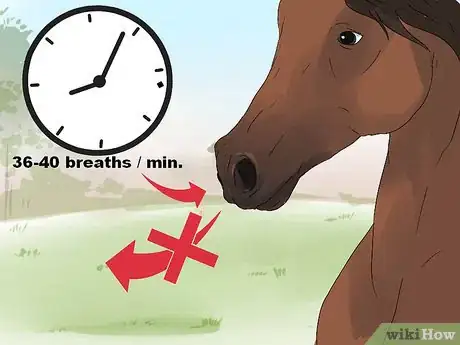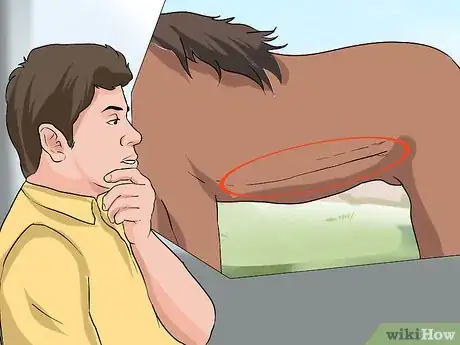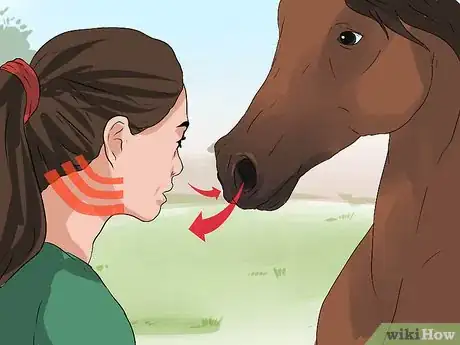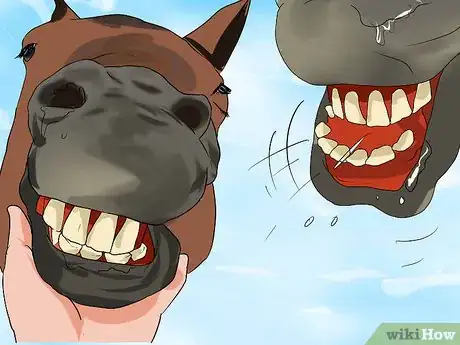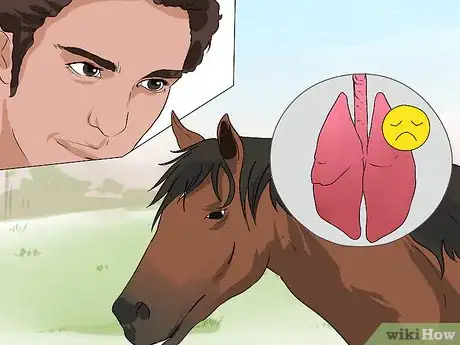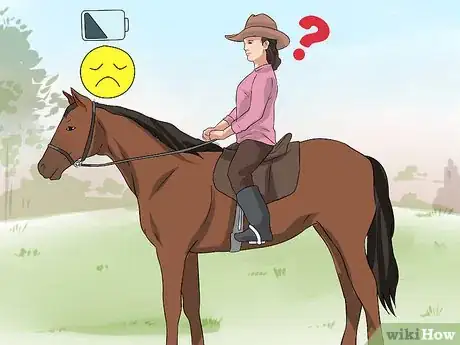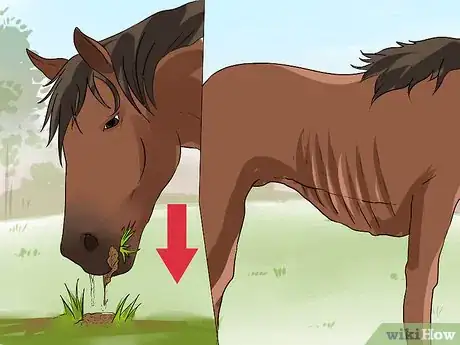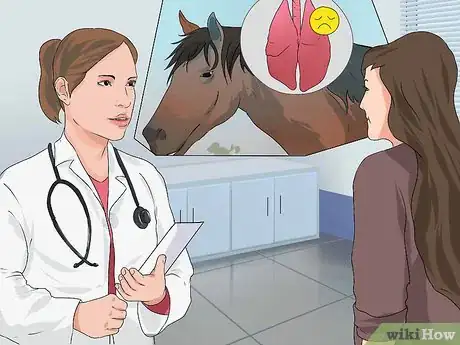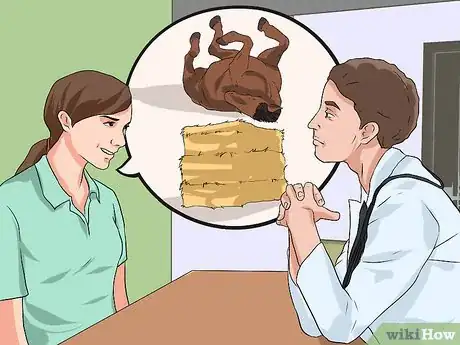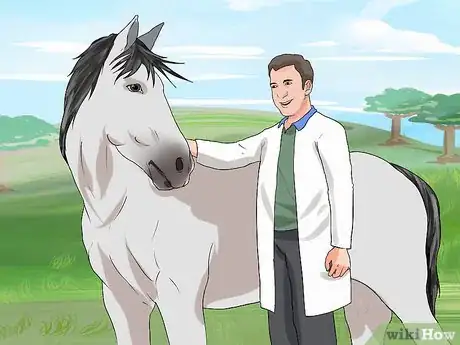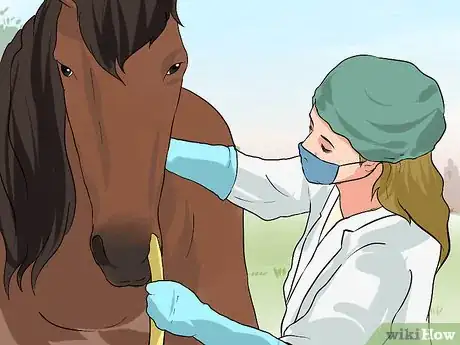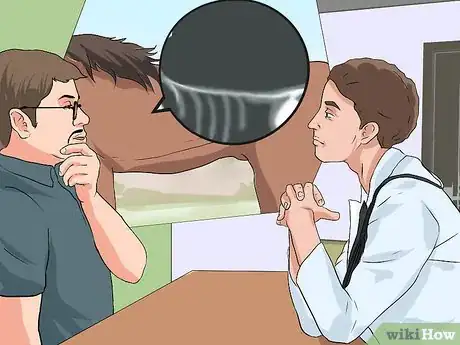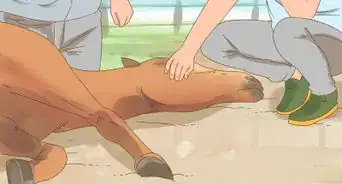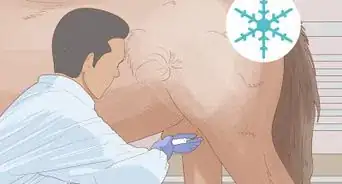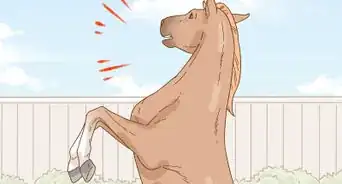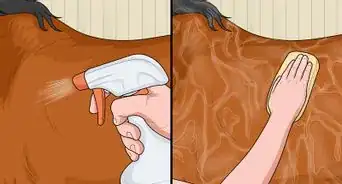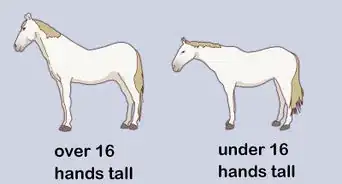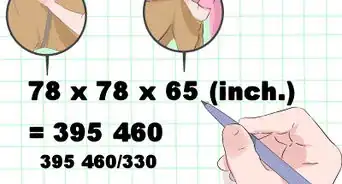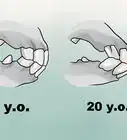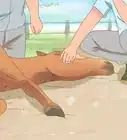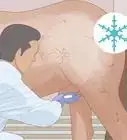This article was co-authored by Ryan Corrigan, LVT, VTS-EVN. Ryan Corrigan is a Licensed Veterinary Technician in California. She received her Bachelor of Science in Veterinary Technology from Purdue University in 2010. She is also a Member of the Academy of Equine Veterinary Nursing Technicians since 2011.
There are 8 references cited in this article, which can be found at the bottom of the page.
This article has been viewed 19,284 times.
Heaves is a respiratory problem that commonly affects adult horses.[1] It occurs when a horse breathes in particles from the environment, called allergens, that cause an allergic reaction in the respiratory tract. This allergic reaction narrows and obstructs a horse’s airways, making it harder for the horse to breathe.[2] Heaves can range from mild to severe. Even mild heaves can become severe, so it is important to recognize heaves as soon as possible so a horse can receive proper treatment.[3]
Steps
Recognizing Breathing-Related Symptoms of Heaves
-
1Watch your horse breathe. Normal breathing for a horse is quiet and doesn’t require much effort. Horses with heaves, though, will have trouble breathing, particularly during exhalation. Your horse will have trouble getting air out of his lungs, so his exhalation will be prolonged and difficult. The extra effort to exhale will require him to use his abdominal muscles, causing those muscles to get larger.[4] [5]
- A horse’s normal breathing rate is 8 to 12 breaths per minute. If your horse has heaves, his breathing rate may be as high as 36 to 40 breaths per minute.[6] Count your horse’s breaths for a minute to determine his breathing rate.
- Your horse may have trouble breathing even when he is at rest.
-
2Locate a heave line on your horse. A heave line, which runs along the bottom edge of a horse’s rib cage, is a telltale symptom of heaves in horses. It forms when the abdominal muscles get larger from the continued effort to exhale.[7] Don’t look for the heave line on your horse right away—it will take some time before his abdominal muscles enlarge enough to form the line.Advertisement
-
3Listen to your horse breathe. As you watch you watch your horse breathe, listen to his breathing sounds. With a severe case of heaves, your horse will wheeze when he breathes.[8] If he has mild case of heaves, he may not make any noise when he breathes.
-
4Observe your horse’s coughing. Within the lungs, the airway inflammation caused by heaves produces mucus.[9] This mucus can block the airways, causing your horse to cough to get the mucus out. Early on in the disease, the cough will be occasional, such as during feeding or exercising. It may or may not produce mucus.[10]
- The cough with a severe case of heaves is very deep and produces pus-like mucus.
- Your horse's cough may become chronic.[11]
-
5Look at your horse’s nose. With all of the extra mucus in your horse’s airways, he may develop nasal discharge, which could look thick and ropy. In addition to discharge, your horse’s nostrils may flare when he breathes because of the increased breathing effort.[12]
-
6Watch for ‘asthma attacks.’ Heaves in horses is similar to asthma in humans. If a heaves-prone horse is stabled indoors, he may have exaggerated responses to environmental allergens.[13] These responses can look like human asthma attacks, in which your horse would have sudden fits of troubled breathing.
Observing Other Heave Symptoms
-
1Determine if your horse is exercising less than usual. Horses are very athletic animals. A horse with heaves, though, will have decreased athletic performance. If your horse has a mild case of heaves, he will not be able to exercise as much as he used to, and will take longer than usual to recover after exercise.[14] You may need to spend more time cooling him down after exercise.
- An inability to exercise in horses is called exercise intolerance. This intolerance will vary according to the severity of heaves.
- For some horses, the only sign of heaves is decreased athletic performance.
- If your horse cannot exercise, do not force him to. This would make it even harder for him to breathe.
-
2Take note of a decreased appetite. As with other animals, horses need a proper diet to be healthy and maintain a good overall body condition. In severe cases of heaves, a horse can become unable to eat because of the struggle to breathe.[15] If your horse cannot eat, he will lose weight.[16]
- At mealtimes, watch your horse to see if he is able to eat.
- Your horse may also drink less water than usual.
-
3Observe changes in your horse’s behavior. The struggle to breathe can make your horse anxious or agitated.[17] Neighing (a high-pitched sound) may indicate anxiety in your horse.[18] Quick and aggressive tail swishing can indicate agitation.
- Your horse may also paw or stamp at the ground with his hooves if he’s feeling uncomfortable.[19]
Getting a Veterinary Diagnosis
-
1Take your horse to your vet. Heaves requires a veterinary diagnosis.[20] Since a mild case of heaves can become more severe, an early diagnosis could help your horse receive treatment before heaves causes serious health consequences.
-
2Provide a detailed history of your horse. Your vet will primarily use your horse’s history and a physical examination to diagnose heaves.[21] The more information you can give your vet about your horse, the better. Important details of your horse’s history include his overall health (e.g., current and previous diseases), diet, housing environment, and when you first started noticing his breathing problems.
- Straw and hay contain allergens that commonly cause heaves in horses.[22] If you use straw or hay for your horse’s bedding, your vet will need to know.
- Tell your vet if your horse’s heave symptoms get worse at certain times. For example, heave symptoms can get worse when a horse is stabled, or out to pasture during the warmer months.
- Cleaning the barn can release dust particles into the air that can worsen your horse’s heaves. Tell your vet often how you clean the barn.
- Horses that are predisposed and previously on pasture may show signs of heaves when they are stabled more than usual.
-
3Have your vet physically examine your horse. Your vet will perform a thorough physical examination of your horse. To listen to your horse breathe, your vet may place a bag over his muzzle. The bag would cause your horse to re-breathe carbon dioxide and make him breathe more deeply, allowing for louder breathing sounds.
- When listening to the breathing, your vet will hear wheezing, as well as rattling noises in the trachea.[23]
- Your vet will also assess your horse’s overall body condition, especially if he has been unable to eat.
-
4Allow your vet to collect a fluid sample. If your vet thinks your horse has mild to moderate heaves, then additional testing would be needed to provide more information about the extent of disease. A technique called bronchoalveolar lavage (BAL) is very useful for diagnosing heaves. BAL allows your vet to take a fluid sample from your horse’s lungs to analyze the inflammatory cells in the fluid.[24]
- To perform BAL, your vet will sedate your horse and pass an endoscope or small camera through his nostrils down to his lungs. Your vet will then pass a saline solution down through the tube and pull it back up to collect the fluid sample.
- BAL is not recommended for horses who have severe breathing problems at rest.[25]
- The turnaround time for this diagnosis is very short. Many vets can run the fluid sample in-house, which means a faster diagnosis and a quicker start to treatment.
-
5Discuss the need for chest x-rays and blood work. In many cases of heaves, x-rays and blood work are not necessary to make a diagnosis. In particular, blood work is usually normal with heaves.[26] Chest x-rays can help rule out other possible causes (e.g., pneumonia, tumors) of your horse’s breathing troubles.[27]
References
- ↑ http://www.merckvetmanual.com/mvm/respiratory_system/respiratory_diseases_of_horses/recurrent_airway_obstruction_in_horses.html
- ↑ http://www.veterinaryextension.colostate.edu/menu2/equine/treatingheaves-1.pdf
- ↑ http://www.ca.uky.edu/agc/pubs/asc/asc172/asc172.pdf
- ↑ http://www.merckvetmanual.com/mvm/respiratory_system/respiratory_diseases_of_horses/recurrent_airway_obstruction_in_horses.html
- ↑ http://edis.ifas.ufl.edu/vm142
- ↑ http://www.horsetalk.co.nz/2012/12/30/heaves-in-horses-dealing-with-copd/#axzz4E76u473c
- ↑ http://edis.ifas.ufl.edu/vm142
- ↑ http://www.ca.uky.edu/agc/pubs/asc/asc172/asc172.pdf
- ↑ http://www.ca.uky.edu/agc/pubs/asc/asc172/asc172.pdf
- ↑ http://www.merckvetmanual.com/mvm/respiratory_system/respiratory_diseases_of_horses/recurrent_airway_obstruction_in_horses.html
- ↑ http://myhorseuniversity.com/resources/eTips/February_2010/Didyouknow
- ↑ http://www.merckvetmanual.com/mvm/respiratory_system/respiratory_diseases_of_horses/recurrent_airway_obstruction_in_horses.html
- ↑ http://www.ca.uky.edu/agc/pubs/asc/asc172/asc172.pdf
- ↑ http://www.ca.uky.edu/agc/pubs/asc/asc172/asc172.pdf
- ↑ http://www.ca.uky.edu/agc/pubs/asc/asc172/asc172.pdf
- ↑ http://edis.ifas.ufl.edu/vm142
- ↑ http://www.ca.uky.edu/agc/pubs/asc/asc172/asc172.pdf
- ↑ http://practicalhorsemanmag.com/article/eqsaying934-11362
- ↑ http://www.equestrianandhorse.com/equus/behaviour.html
- ↑ http://edis.ifas.ufl.edu/vm142
- ↑ http://www.merckvetmanual.com/mvm/respiratory_system/respiratory_diseases_of_horses/recurrent_airway_obstruction_in_horses.html
- ↑ http://www.veterinaryextension.colostate.edu/menu2/equine/treatingheaves-1.pdf
- ↑ http://www.merckvetmanual.com/mvm/respiratory_system/respiratory_diseases_of_horses/recurrent_airway_obstruction_in_horses.html
- ↑ http://www.veterinaryextension.colostate.edu/menu2/equine/treatingheaves-1.pdf
- ↑ http://www.merckvetmanual.com/mvm/respiratory_system/respiratory_diseases_of_horses/recurrent_airway_obstruction_in_horses.html
- ↑ http://www.merckvetmanual.com/mvm/respiratory_system/respiratory_diseases_of_horses/recurrent_airway_obstruction_in_horses.html
- ↑ http://www.veterinaryextension.colostate.edu/menu2/equine/treatingheaves-1.pdf
- ↑ http://www.veterinaryextension.colostate.edu/menu2/equine/treatingheaves-1.pdf
- ↑ http://www.merckvetmanual.com/mvm/respiratory_system/respiratory_diseases_of_horses/recurrent_airway_obstruction_in_horses.html
About This Article
To diagnose heaves in your horse, watch for common symptoms, like difficulty breathing or rapid breaths. For example, while a horse normally takes 8 to 12 breaths per minute, it may take up to 40 if it has heaves. You should also look for a heave line on your horse near the bottom of its rib cage, which is caused by the abdominal muscles working harder to breathe. If the heaves are severe, you'll be able to hear wheezing sounds when your horse is breathing. Additionally, note if your horse coughs regularly, which is caused by a build-up of mucus in the lungs. As soon as you notice any of these symptoms, take your horse to your vet for a diagnosis, since even a mild case of heaves can get worse. Your vet will ask you about your horse’s medical history and conduct a physical exam to confirm the diagnosis. For tips from our Veterinary co-author, including how to know when your horse may need blood tests, keep reading!
